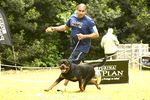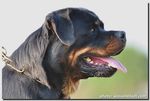The 7 Deadly Breed Type Faults - The ROTTWEILER Workshop - Medallion Rottweiler Club
←
→
Page content transcription
If your browser does not render page correctly, please read the page content below
The ROTTWEILER
Workshop “a student of the breed needs the right tools ”
C
The 7 Deadly Breed Type Faults
July 2018
In this issue
The 7 Deadly Breed In my youth class at an initial judging assignment was a typical Rottweiler dog.
Type Faults He was powerful with substantial bones, dark eyes and good head type; I liked him. But
he had an unforgiving flaw, pink gums! I could not overlook it and placed him 5th in a
class of 8. The owner, furious with my decision approached angrily, “Why didn’t you
give my dog a higher placement? I thought you would like him, that’s why I entered the
show.” “I did like him, but he has a serious fault.” “What’s that?” “He has pink gums.
That’s a breed type fault in the Standard.” “Oh, he’s young. It will get darker when he is
older.” “OK, bring him back to me then.”
Every Breed Standard has a faults list. With a purpose to eliminate or diminish,
it highlights undesirable traits. The Rottweiler Standard has an extensive registry con-
taining flaws of three classes. One is structural relating to the skeletal anatomy. The
second relates to is character/temperament. Third is the general appearance, its breed
type. There are 7 Deadly Breed Type Faults, which are undesirable. It is the topic for
the July 2018 issue of the Rottweiler Workshop.
1. Pink Gum Pigmentation
From the Standard: Lips: Black, close fitting, corner of the mouth not visible,
gum dark. Initially, pink gums were believed to be associated with a lack of vitality.
Therefore, it is faulty, and the Standard lists it for elimination. The ideal color is dark
chocolate.
We encounter many variations of pink gum pigmentation ranging from dark
gums spotted with small pink blotches to complete bubblegum pink.
• Total pink inner mouth pigmentation
• 75% pink, 25% dark
• 50% pink, 50% dark
• 25% pink, 75% dark
• Dark possessing a few light areas
• Rose color gum pigmentation
Dark gum and lip pigmentation go together. But pink spots may appear along the
lip-line. Often, as the dog matures - about 7 years - the gums may grow lighter in
1color and acquire pink spotting. The range of gum color often observed are depicted in 1-3 with 3 being the
most desirable. Note: colors are approximations. Some will rationalize their dogs possessing pink gums say-
ing, “Pink gums are caused by external forces, the environment, etc. It is an excuse.
Fig. 1 Fig. 2 Fig. 3
2. Light Eye Color
From the Standard: Eyes: Of medium size, almond shaped, dark brown. Eyelids close fitting. The
range of observable eye color is 1a, the darkest to 6, the lightest. Fig. 4 is the Eye Chart used to designate the
eye color of a Rottweiler.
Dark eyes ensure the fearless and confident expression so desirable in
the Rottweiler. Light eyes create an uncertain and apprehensive appearance. The range of
acceptable color is 1a-3a. 3b and above are not.
Light eye color is the most challenging breed type fault to eliminate. Once intro-
duced into a pedigree, it can take many generations to eradicate. Eye color is inherited.
2.1 Atypical Eye Geometry Fig. A Fig B
The geometry of the eye is also significant. From the Standard: Of medium size,
almond shaped, dark brown. Eyelids close fitting. The eye shape is almond Fig. A
The eyelids should be tight fitting with no ocular discharge. Often observable are loose-
fitting or drooping eyelids Fig. B. Associated with lax eyelids is ocular discharge oozing
Fig.4 from the corners of the eye and the disorder ectropion.
2.2 Hairless Eyelids Fig.5
The eyelids should not be hairless. Some eyelids
possess a white crusty coating and are without hair. Fig 5. Hairless
eyelids are faulty.
2.3 Round Eyelids
The eyelids are almond shape and should not be round Fig. 6
2 Fig.6Fig.7
Correct eyes. They are dark, almond shape, tightfitting eyelids,
hair present on eyelids with no ocular discharge Fig. 7
3. Atypical Head Type
The Standard, referring to the head’s geometry states: Skull: Of medium length, broad between
the ears. Forehead line moderately arched as seen from the side. Occipital bone well developed without
being conspicuous.
• Stop: Well defined.
• Nose: Well developed, broader than round with relatively large nostrils, always black.
• Muzzle: The foreface should appear neither elongated nor shortened in relation to the cranial
region. Straight nasal bridge, broad at base, moderately tapered.
• Cheeks: Zygomatic arches pronounced.
The muzzle is broad at the base. The zygomatic arch is pronounced. The stop is well defined and
forehead line is moderately arched as seen from the side. These are the head’s defining metrics. The atypical
head type does not contain the correct geometries. It has a shallow muzzle at the base, shallow stop and no,
to slight, pronunciation of the zygomatic arch, significant breed type flaws.
Next is the extreme/hyper head type - also atypical. It has an exaggerated stop, zygomatic arch, and
dome-shaped skull including an incorrect muzzle to skull ratio of 65/35 instead of the correct 60/40. It is the
head of a Boxer. It too has significant breed type flaws.
Fig. 8 Atypical Bitch Head Type Fig. 9 Atypical Dog Head Type
Fig. 8-9 possess a shallow stop and zygomatic arch.
3Fig. 10 Atypical Hyper Head Type Fig. 11 Atypical Hyper Head Type
Fig. 10 -11 possess an exaggerated stop, zygomatic arch, a dome shape skull and
a muzzle ratio outside the boundary of the 1.5x1.0 ratio
Fig. 12 Typical Dog Head Type Fig. 13 Typical Bitch Head Type
Fig. 12 -13 possess correct stop, arch of skull, zygomatic arch,
skull to muzzle ratio
3.1 Dome Shape Skull
The skull should be slightly arched according to the Standard Fig.14. From the Standard: Forehead
line moderately arched as seen from the side. But we observe heads that are “hyper type” – the head of a
Boxer – possessing an exaggerated stop and skull geometry of a dome Fig. 15. These head geometries are
incorrect.
Fig.14 Correct Slightly Arched Fig. 15 Incorrect Dome Shape
44. Loose Skin
From the Standard: Skin on the head: Overall tight fitting. When the dog is alert, the forehead
may be slightly wrinkled. Lips, close-fitting, corner of the mouth not visible. Neck, free from throati-
ness. Eyelids close fitting.
Ideally, the skin should be tight fitting on the entire body and face like the Dobermann. No loose skin
Fig.16 -17 should be visible anywhere except for a slight elasticity near the corner of the mouth when the dog
is panting. Some wrinkling on the skull is acceptable. Often, we observe the following,
• Loose flews.
• Drooping Eyelids. See Fig. B page 2
• Excess skin on the head, cheeks and throat.
• Excess skin on the shoulders.
Fig. 16 Fig. 17
5. Long in Body
From the Standard: His correctly proportioned, compact and powerful build leads to the conclu-
sion of great strength, agility, and endurance. The length of the body, measured from the sternum
(breast-bone) to the ischiatic tuberosity, should not exceed the height at the withers by 15%. Fig. 18
Despite the Standard acknowledging a variance in body length and stating, “should not exceed the
height at the withers by, at most, 15%, the significant
word is “Compact.”
If a dog measures 66cm in height and we follow the
9/10 body ratio set in the ADRK chart (at right Fig. 18), the
correct body length is 73.33cm. But we recognize all dogs
will not fit precisely into the ratio and accept a maximum of
15% extra body length - somewhat longer – of 75.9cm.
Long in body alters the Rottweiler’s compact ap-
pearance, its breed type. Many Rottweilers exceed the ac-
ceptable metrics in body length. It is a worldwide dilemma.
Long in body begets longer. It is a serious breed type flaw.
See Fig. 19-20 next page. Fig. 18
5Fig.19 Correct Compact Body 9/10 ratio Fig.20 Incorrect Long Body 9/12 ratio
6. Light Markings
The most desirable color for markings is mahogany Fig. 21. But there are other colors which
are faulty. Straw color markings are undesirable and flawed Fig. 22. Note: Colors are approximations.
Fig. 21 Mahogany is Correct Fig. 22 Straw is Incorrect
6.1 Dark Markings
Dark Markings - also called sooty - are as faulty as light. They change the Rottweiler’s appearance,
its breed type. Sooty markings are often observed on the pasterns - front and rear - and the face and chest. It
is the abundance of darker hairs overpowering the lighter ones. Fig. 23-24.
Fig. 23 Fig. 24
67. Light in Body, Bone Mass, Muscle
The Standard states: The Rottweiler is a medium to large size, stalwart dog, neither heavy nor
light and neither leggy nor weedy. His correctly proportioned, compact and powerful build leads to the
conclusion of great strength, agility, and endurance. General appearance: Light, weedy, leggy appear-
ance. Light in bone and muscle is faulty.
Light in body, bone mass, and muscle alters the appearance of the Rottweiler from the powerful to
frail/weak. It is self-perpetuating when using breeding partners with this condition. Fig 25-26
Fig 25 Fig 26
7.1 Too Heavy in Body, Bone Mass, and Muscle
Overly heavy body, bone, and muscle mass also change breed type. It has the opposite effect of the
former traits making the Rottweiler appear exaggerated and unwieldy. Bone mass is determined by taking a
tape measure, wrap it around the front pastern – the area with the least number of tendons and muscle – and
obtaining its circumference. A dog’s bone, body and muscle mass should be in proportion to its height.
Summary
The 7 Deadly Breed Type Faults are the most common and inherited. They do not mysteriously
appear as some claim. Once these faults are introduced in a breeding program, they can take many genera-
tions to eliminate. Rottweilers with these faults should not be awarded with a “V” rating. A careful, thor-
ough inspection of breeding partners possessing these faults should be made before making any decisions
whether to use or not. The same prudent measures should be made when selecting puppies, young adults,
adults, Stud dogs and Brood bitches.
7Three most valuable seminars available to Rottweiler Clubs to conduct in conjunction
with shows. For information on their presentation contact Steve Wolfson
No portion of the Rottweiler Workshop can be copied or reproduced without written permission.
If subscribers wish to comment pro, con or ask questions about anything written, please email.
Subscribers that want to recommend others to be added to the
subscriber’s list just email me.
8
Steve Wolfson snwolfson@optonline.netYou can also read



























































